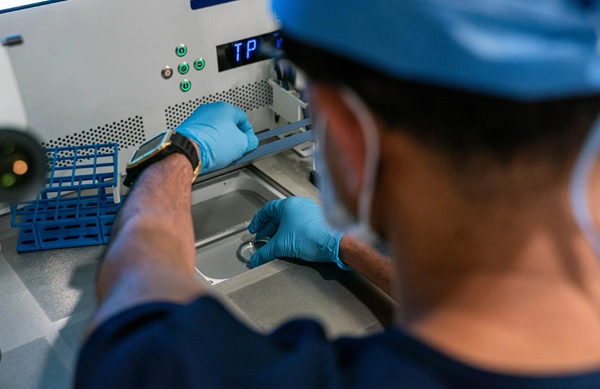
In Vitro Fertilization

Come for our expertise, stay for our care.
IVF is the most well-established, effective treatment for fertility. It provides the highest pregnancy rates but also requires the most involvement. Our goal is to ensure you are confident and empowered through every step of your journey. At Tripod, we want to give you the highest chance of success, while being a warm place that you can rely on during this incredibly important time in your life.

A Stimulated IVF cycle involves stimulating the ovaries to produce the highest number of eggs you can safely make in one month. The average IVF cycle takes around 2-3 weeks to complete.

What to expect

Preparation and Education
- In the month leading up to your cycle, you’ll meet our nursing team to learn about the IVF process and how to self-administer medication. Our goal is to ensure you move forward with your treatment feeling confident and at ease.
Day 1
- This is the first day of your menstrual cycle. Your IVF cycle begins! Our nursing team will be with you during every step.
Cycle Monitoring & Ovarian Stimulation
- Over the next 10-14 days, you’ll be taking injectable medication to grow multiple eggs and suppress ovulation. During this phase, you’ll need 3-6 morning appointments to monitor your progress with blood tests and internal ultrasounds. Once the eggs reach an optimal size and number, you’ll take a final injection to prepare you for the egg retrieval.
Egg & Sperm Collection
- The Egg Retrieval is a 15-30 minute procedure inside our Operating Room. At Tripod, an Anesthesiologist is present to provide deep sedation and ensure you are comfortable and free of pain.
- Sperm will be collected from your partner or donor on the same day as the egg retrieval. If sperm was frozen in advance, we’ll thaw it on this day.
Fertilization & Embryo Culture
- A few hours after the egg retrieval, an embryologist will combine the eggs and sperm in hopes of fertilization. Your embryos will be closely monitored and grown in our time-lapse incubator over the next 5-7 days. Our embryology team will contact you regularly throughout this week to let you know how your embryos are doing.
Embryo Transfer
- A fresh, untested embryo can be transferred 3-6 days after the egg retrieval. If the conditions are not optimal for a fresh embryo transfer or if you choose to pursue genetic testing, your embryos are frozen and stored for a future transfer.
- During the transfer, your embryo is placed inside a catheter and carefully inserted into the uterus under ultrasound guidance. The procedure is painless and takes around 10-15 minutes.
Pregnancy Test
- We can do a pregnancy blood test 12-14 days after your embryo transfer. If the test is done at our clinic, we’ll have the results for you on the same day.
A Natural IVF Cycle uses similar processes as conventional (Stimulated) IVF but doesn’t require stimulation medication. Natural IVF results in 1-2 eggs per cycle but allows you to avoid medication and pursue a more natural approach. It’s also ideal for patients who have delicate ovaries or who haven’t had success with conventional IVF treatments.

What to expect

Preparation and Education
- In the month leading up to your cycle, you’ll meet our nursing team to learn about the IVF process. Our goal is to ensure you move forward with your treatment feeling confident and at ease.
Day 1
- This is the first day of your menstrual cycle. Your IVF cycle begins! Our team, featuring some of the best fertility doctors in Toronto will be with you during every step.
Cycle Monitoring
- Over the next 2 weeks, we’ll track your cycle to closely monitor the growth of an egg. You’ll need 2-4 morning appointments for blood tests and internal ultrasounds. Once the egg reaches an optimal size, you’ll be ready for the egg retrieval.
Egg & Sperm Collection
- The Egg Retrieval is a 15-30 minute procedure inside our Operating Room. At Tripod, an Anesthesiologist is present to provide deep sedation and ensure you are comfortable and free of pain.
- Sperm will be collected from your partner or donor on the same day as the egg retrieval. If sperm was frozen in advance, we’ll thaw it on this day.
Fertilization & Embryo Culture
- A few hours after the egg retrieval, an embryologist will combine the egg and sperm in hopes of fertilization. Your embryo will be closely monitored and grown in our time-lapse incubator over the next 5-7 days. Our embryology team will contact you regularly throughout this week to let you know how your embryo is doing.
Embryo Transfer
- A fresh, untested embryo can be transferred 3-6 days after the egg retrieval. If the conditions are not optimal for a fresh embryo transfer or if you choose to pursue genetic testing, your embryos are frozen and stored for a future transfer.
- During the transfer, your embryo is placed inside a catheter and carefully inserted into the uterus under ultrasound guidance. The procedure is painless and takes around 10-15 minutes.
Pregnancy Test
- We can do a pregnancy blood test 12-14 days after your embryo transfer. If the test is done at our clinic, we’ll have results to you on the same day.
A Mini (minimal stimulation) IVF is just like conventional IVF, but with lower doses of stimulation medication. Other common names for this cycle include low stim, miniature, or micro-IVF. This protocol uses fewer medications to produce a smaller number of high-quality eggs. It’s ideal for patients who have low or diminished ovarian reserve who wouldn’t necessarily be getting any more eggs by taking more medication. As a result, these patients can pursue treatment at a lower cost and reduced risk of hyperstimulation. Alternatively, some patients may opt for this protocol due to personal reasons of not wanting to have a large number of remaining embryos after achieving their family building goals.

What to expect

Preparation and Education
- In the month leading up to your cycle, you’ll meet our nursing team to learn about the Mini IVF process and how to self-administer medication. Our goal is to ensure you move forward with your treatment feeling confident and at ease.
Day 1
- This is the first day of your menstrual cycle. Your IVF cycle begins! Our nursing team will be with you during every step.
Cycle Monitoring & Ovarian Stimulation
- At the start of your cycle, you’ll be prescribed medication to develop a small number of high-quality eggs and suppress ovulation. This typically involves oral tablets for around 5 days, followed by injectable medication for an additional 3-5 days. During this phase, you’ll need 2-4 morning appointments to monitor your progress with blood tests and internal ultrasounds. Once the eggs reach an optimal size and number, you’ll take a final injection to prepare you for the egg retrieval.
Egg & Sperm Collection
- The Egg Retrieval is a 15-30 minute procedure inside our Operating Room. At Tripod, an Anesthesiologist is present to provide deep sedation and ensure you are comfortable and free of pain.
- Sperm will be collected from your partner or donor on the same day as the egg retrieval. If sperm was frozen in advance, we’ll thaw it on this day.
Fertilization & Embryo Culture
- A few hours after the egg retrieval, an embryologist will combine the eggs and sperm in hopes of fertilization. Your embryos will be closely monitored and grown in our time-lapse incubator over the next 5-7 days. Our embryology team will contact you regularly throughout this week to let you know how your embryos are doing.
Embryo Transfer
- A fresh, untested embryo can be transferred 3-6 days after the egg retrieval. If the conditions are not optimal for a fresh embryo transfer or if you choose to pursue genetic testing, your embryos are frozen and stored for a future transfer.
- During the transfer, your embryo is placed inside a catheter and carefully inserted into the uterus under ultrasound guidance. The procedure is painless and takes around 10-15 minutes.
Pregnancy Test
- We can do a pregnancy blood test 12-14 days after your embryo transfer. If the test is done at our clinic, we’ll have the results for you on the same day.
Our IVF and Fertility Treatment Success
600+
Babies born
4.4
Star google rating
9
Years of creating families
Our Friendly Team
We believe it’s our team that sets us apart. We are a group of experienced, passionate, kind people whose mission is to improve the standard of patient care. We can’t wait to meet you.



